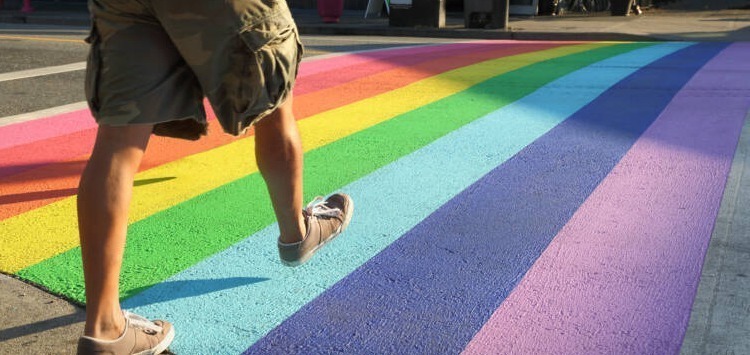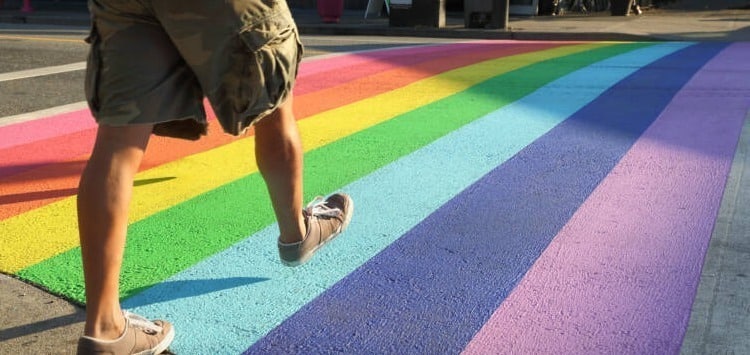Doing everything right. On the endeavour of a queer art action to conquer a gay men's sauna.
Marco Kammholz
An exhibition review of queertopolis. 18-19 May 2022, Sommerblut Festival, Phoenix Sauna, Cologne.
"Desire yourselves!"[1] is the title of the announcement for an art and performance event in the temporary cultural and sauna landscape queertopolis in Cologne. It is an ambitious project that the artists and activists want to dedicate themselves to as part of the annual Sommerblut festival and it fits perfectly into the programme of the alternative cultural project Summer blood. Following the coronavirus lockdowns and the recent festival cancellation due to the pandemic, the organisers quickly proclaimed a "festival of radical love". "Now is the time for new forms of community, encounters and liveliness!" was the passionate, but also slightly threatening message for the two-week programme. The organisers of queertopolis already demonstrated their ambition in their unassuming claim to proclaim a "queer utopia of desire" - mind you, in the Phoenix Sauna, a popular venue among gay men, a place that is exclusively available to men for sex with men outside of the art festival.
As far as the content of the art project is concerned, it is no coincidence that "Desire yourselves!" in the event title oscillates between invitation, invitation and command. With their unconventional description of contemporary sexual and body culture, the artists immediately deliver a judgement and mandate in one: "In a public sphere in which heterosexual, monogamous relationships, often led by young, white bodies without disabilities, form the norm, the diversity of physicality, love and desire often remains invisible. We want to change that!"
While the project management by Jakob Heimbach and the artistic direction by Martin Zepter and Elle Fierce mentioned on the festival homepage suggest an exhibition organised as in the classical art world, visitors to the exhibition and performances get a different impression after just a few moments. A large number of activists and artists are evidently involved in the queertopolis art project, which can be attributed to the management's desire to include the various groups in the LGBTIQ spectrum in the planning and design. The numerous rooms and booths that have been remodelled to varying degrees, the various workshops on offer, the meticulously staffed awareness team and the many different people offering performances and discussion spaces are all evidence of this. Under the direction of the queer artists, the gay sauna, which is normally shrouded in gloomy light and driving techno, presents a completely different picture. In quite a few places, regular visitors to the cruising venue cannot help but get the impression that the meeting place for sex encounters of the rather anonymous and fast kind is simply being turned into its opposite: an obsessively plural feel-good oasis of security and control. Where the entrance to the location would otherwise feature naked, tiled corners inviting everyone present to have sex in full view, there are now plush blankets, a canopy and a unicorn cuddly toy to boot. Where there would otherwise be darkness and confusion, there is now colourful lighting and orientation aids. Where there are usually cabins for sex for two or more people, there are now small audio-visual exhibitions and, above all, invitations to self-reflection. In any case, explicit and implicit calls for reflection and self-examination are omnipresent. "Who are you when you're alone?", "What is your queer utopia?", "Mediation and quiet room", "Queer and religiosity discussion group"... as a visitor, you are always addressed in a friendly, but at the same time intrusive and educationally demanding manner. As a result, the exhibition unfortunately fails to realise its own potential: instead of maintaining the atmosphere of an experiential space of sexual tension, dubiousness and alienation that is genuine for gay saunas, at least in sufficient parts, and making it available to an extended group of people, queertopolis remains far too clearly focused on making its visitors feel comfortable and finding themselves. This is particularly evident in the protection and awareness concept, which is undoubtedly emphasised by the creators as the most stringent element of the exhibition. Not only were visitors made aware in advance by email, by being addressed in the queue, by signing at the entrance, by notices, announcements and, finally, by safety officers marked with lights during the event, of how serious the organisers are about taking precautions to prevent possible assaults, but in addition, only the "Labyrinth of Passion" was available for sexual contact anyway. This was to be understood as "a sex-positive space for hot, tender, consensual togetherness where you are invited to have fun and get closer to each other"; in all other locations, "talking and thinking about sex is welcome, but sexual interaction is not desired". The exhibition's well-intentioned but unfortunately overemphasised awareness concept provokes some critical questions about the gender-reflective implications of the event: do the organisers consider a gay sauna or the queer utopia they have proclaimed to be dangerous in principle? What ideas of sexuality come into play here? And are the "FLINTA people"[2], who are much emphasised in the exhibition space, understood as primarily in need of protection and care?
Nevertheless, an exclusively harsh criticism of the exhibition's focus, which prioritises attitude and education over ambivalence and disturbance, does not do justice to the successful aspects of queertopolis. The sexual education programmes on the upper floor of the sauna were not only visibly popular during the exhibition days, but undoubtedly represent an exciting addition to the regular offerings of a sex sauna. Why not give visitors the opportunity to gain low-threshold and action-orientated insights into bondage practices or sex toys, for example, if they are interested? Gay saunas could certainly be inspired by this. The interview conducted by the queer artists with the AIDS contemporary witness and founder of the gay Phoenix sauna in one of the art cabins also fits in pleasantly and elegantly with the artistic events, above all because the interviewees see themselves as listeners. The joy and humour that the (sometimes irritating) cross-gender encounters in the sauna rooms made possible can also be clearly felt in the atmosphere and, for brief moments, actually allow a more informal and therefore freer relationship between the sexes to come to life. However, whether the heterogeneity that queer activists are so keen to promote and the strenuous insistence on desire without exclusion (experience) is really so conducive to sexual passion and adventurousness is another matter. Sex parties with queer-feminist aspirations are known to rarely lack diversity awareness and concepts to protect boundaries, but the event itself often does: Sex. What is striking about the queertopolis event in the Phoenix Sauna, which celebrates the plural, is that the "queer utopia" tends to appeal to a homogeneous group, as it is mainly younger and middle-aged women and queers with an obvious affinity for the symbolism and gestures of queer-feminist subculture who frequent the space. However, the initiative also succeeded in doing something that the vast majority of sexuality-affirming and subcultural events almost always lack: making it possible for people with disabilities to participate, which was ensured on both days of the event, for example, by offering sign language translation or visual accompaniment. In contrast to many other rooms that were deliberately designed to be more accessible, the offer was actually utilised in this case.
The performance by Leipzig-based artist and dancer Elle Fierce was another artistic highlight of the exhibition: The interaction, remarkably announced as a "consensus performance", allowed itself the moments of ambiguity, confrontation and border-crossing that were generally neglected in the exhibition. Fierce used a small room normally used for anonymous group and, above all, fisting sex under video recording and lay naked and wearing a black motorbike helmet in a sling. The artist didn't have to do much more than that, as the visually and meaningfully powerful performative setting immediately put the room and its visitors in a mood of tension and excessive demands, especially due to the evoked failure of social categorisation of the situation. Anyone entering the performance consented to the video recording and the use of their own image, but could also wear a black motorbike helmet. It was precisely these helmets that broke through the communication via gaze and word and created a situation peculiar to cruising. What's more, the motionless artist did not react to any touch or contact. Here, the dynamics of delivery, empowerment and utilisation in their ambivalence and fragility between pleasure and danger appeared in an extremely impressive way, but without - as in large parts of the rest of the exhibition - ending in explanation or instruction. It is only at this point that the exhibition ultimately raises questions of artistic and queer-political significance in a profound and tangible way: What does the presence of the Other trigger in me? And what have I (not) done? And can this even be grasped and resolved in sexual communication?
[1]Taken from the facebook event: https://www.facebook.com/events/1573825809749586/1573825816416252/?active_tab=about
[2] In this queer-feminist context, FLINTA stands for the conceptual summarisation of non-cis-male gender identities and self-concepts which, in addition to women, explicitly refer to lesbians, inter, non-binary, trans and so-called agender people.

Photo: ©maxdigi/stock.adobe.com

